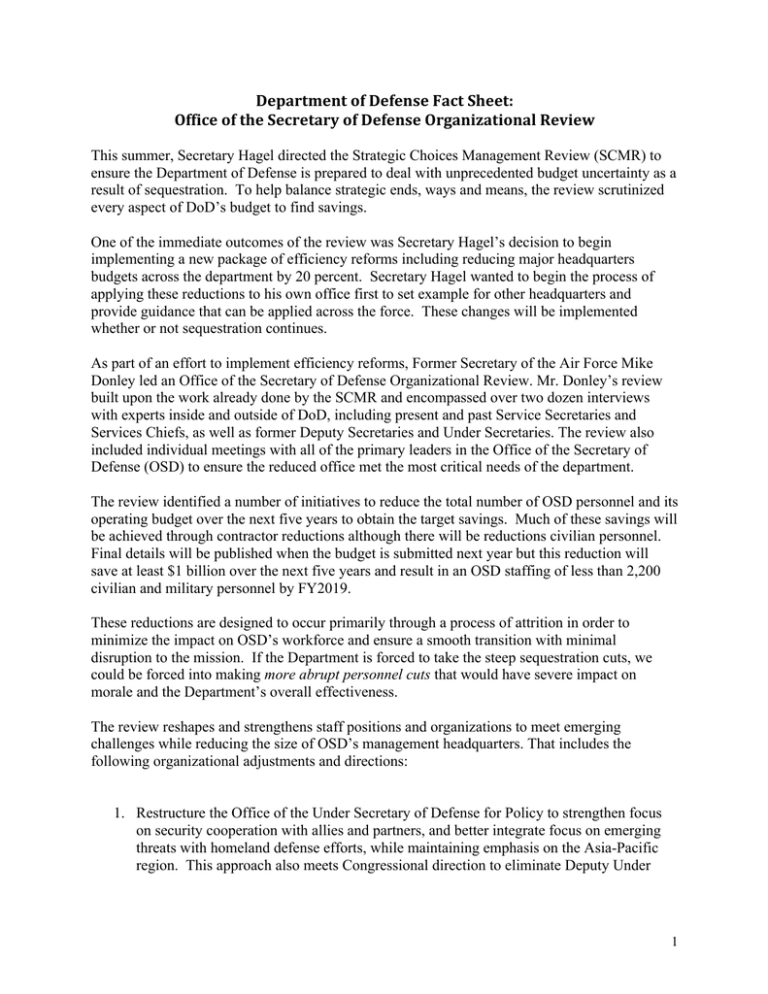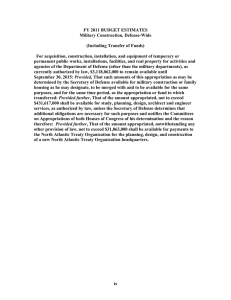Document 11683800
advertisement

Department of Defense Fact Sheet: Office of the Secretary of Defense Organizational Review This summer, Secretary Hagel directed the Strategic Choices Management Review (SCMR) to ensure the Department of Defense is prepared to deal with unprecedented budget uncertainty as a result of sequestration. To help balance strategic ends, ways and means, the review scrutinized every aspect of DoD’s budget to find savings. One of the immediate outcomes of the review was Secretary Hagel’s decision to begin implementing a new package of efficiency reforms including reducing major headquarters budgets across the department by 20 percent. Secretary Hagel wanted to begin the process of applying these reductions to his own office first to set example for other headquarters and provide guidance that can be applied across the force. These changes will be implemented whether or not sequestration continues. As part of an effort to implement efficiency reforms, Former Secretary of the Air Force Mike Donley led an Office of the Secretary of Defense Organizational Review. Mr. Donley’s review built upon the work already done by the SCMR and encompassed over two dozen interviews with experts inside and outside of DoD, including present and past Service Secretaries and Services Chiefs, as well as former Deputy Secretaries and Under Secretaries. The review also included individual meetings with all of the primary leaders in the Office of the Secretary of Defense (OSD) to ensure the reduced office met the most critical needs of the department. The review identified a number of initiatives to reduce the total number of OSD personnel and its operating budget over the next five years to obtain the target savings. Much of these savings will be achieved through contractor reductions although there will be reductions civilian personnel. Final details will be published when the budget is submitted next year but this reduction will save at least $1 billion over the next five years and result in an OSD staffing of less than 2,200 civilian and military personnel by FY2019. These reductions are designed to occur primarily through a process of attrition in order to minimize the impact on OSD’s workforce and ensure a smooth transition with minimal disruption to the mission. If the Department is forced to take the steep sequestration cuts, we could be forced into making more abrupt personnel cuts that would have severe impact on morale and the Department’s overall effectiveness. The review reshapes and strengthens staff positions and organizations to meet emerging challenges while reducing the size of OSD’s management headquarters. That includes the following organizational adjustments and directions: 1. Restructure the Office of the Under Secretary of Defense for Policy to strengthen focus on security cooperation with allies and partners, and better integrate focus on emerging threats with homeland defense efforts, while maintaining emphasis on the Asia-Pacific region. This approach also meets Congressional direction to eliminate Deputy Under 1 ON EMBARGO UNTIL DELIVERY OF SECDEF/CJCS PRESS CONFERENCE DECEMBER 4, 2013 Secretary positions by re-balancing workload across Assistant Secretaries of Defense (ASDs). Key realignments include eliminating the Deputy Under Secretary of Defense, Plans, and Forces (DUSD(SPF)) and moving those and other realigned functions to a new ASD for Strategy, Plans, and Capabilities (SPC); merging several functions of the ASD for Global Strategic Affairs including cyber, space, and counter-WMD policy with the ASD for Homeland Defense to create a stronger and more comprehensive approach to the defense of the homeland; and eliminating the Under Secretary's Chief of Staff position, as well as four Deputy Assistant Secretary of Defense (DASD) positions and support staff through consolidation and realignment of the overall DASD structure. 2. Strengthen the Office of the Deputy Chief Management Officer (DCMO) to better coordinate and integrate DoD’s business affairs by creating a leadership focused on management concerns and creating a single management, business oversight, and administrative organization within OSD and across DoD. This will be done by realigning the Director of Administration and Management (DA&M) and its components under the DCMO, and with help from Congress, realign oversight of business systems from DCMO to the DoD CIO. The new DCMO will focus on four activities: management, policy, and analysis; administration; planning, performance, and integration; and compliance and open government. 3. Strengthen the Office of the DoD Chief Information Officer’s (CIO) by improving its oversight of IT resources, and realigning oversight of business systems from the DCMO to the DoD CIO. This will allow the DoD CIO to better address growing information technology and cyber challenges and better enable implementation of the Joint Information Environment. The Under Secretary of Defense for Acquisition, Technology, and Logistics will continue to be responsible for acquisition of IT systems. 4. Combine the Office of the Assistant to the Secretary of Defense for Intelligence Oversight with the Defense Privacy and Civil Liberties Office under the DCMO to combine organizations with similar compliance oversight and reporting functions. Further, this merger streamlines DoD processes and interactions with external offices, under a single official. 5. Realign the Office of Net Assessment (ONA) under the Office of the Under Secretary of Defense for Policy preserving it as a distinct organizational unit that reports to the Secretary of Defense, through the Under Secretary of Defense for Policy. This arrangement better ensures that ONA’s long-range comparative analyses inform and influence the department’s overall strategy and policy at all levels in the department. 6. Rebalance internal resources across the Office of the Under Secretary of Defense for Personnel and Readiness consistent with a focus on force management, readiness, and health of the force (including broader issues of compensation and retirement). The goal is to better position the office to address major concerns related to DoD downsizing such as readiness, total force management, and compensation. 2 ON EMBARGO UNTIL DELIVERY OF SECDEF/CJCS PRESS CONFERENCE DECEMBER 4, 2013 7. Rebalance the Office of the Under Secretary of Defense for Intelligence (OUSD(I)) to establish post-9/11 and post-Operation Iraqi Freedom/Operation Enduring Freedom steady-state intelligence oversight configuration and level of effort. This coming effort is intended to align OUSD(I) to core functions and is expected to identify non-core functions and programs that may be transferred to the services or defense agencies. 8. Eliminate the five remaining non-Presidentially Appointed, Senate-confirmed (non-PAS) Deputy Under Secretaries of Defense, fulfilling the direction from Congress. Treatment includes: the DUSD for Installations and Environment (I&E) will be merged with the ASD for Operational Energy Plans and Programs (OEP&P); the DUSD(SPF) would be eliminated and the functions realigned into ASD(SPC), as indicated above; and the three non-PAS DUSDs in OUSD(I) will be re-designated as Directors for Defense Intelligence. The Secretary has directed that all of these organizational changes to begin immediately and be in place by January 1, 2015. OSD leaders will provide further information to their staffs in the coming days and weeks to begin these transitions. Combatant Commanders, Service Chiefs, and other headquarters leaders across the Department of Defense are in the process of finalizing their organizational reviews and plans to meet the 20% budget reduction. These reviews will be submitted as part of the President’s FY2015 budget request next year. ### 3


